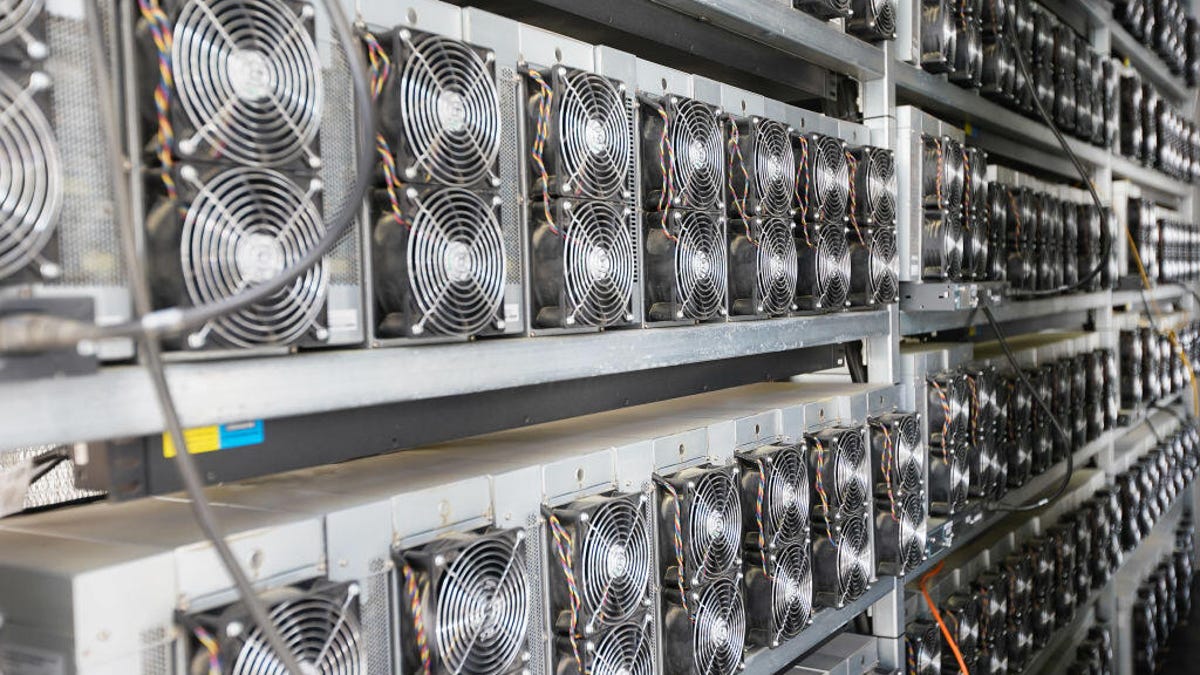How Much Power Does Crypto Use? The Government Wants to Know
The mining of bitcoin and other cryptocurrencies uses a lot of electricity -- more than many countries. Are you paying for it on your power bill?

Bitcoin-mining operations, like this one in Georgia photographed in 2022, use large amounts of electricity. That's drawing the attention of the federal government, which wants more information on the industry's impact on the energy system.
Think if you don't buy bitcoin, the whole cryptocurrency craze doesn't affect you? Think again.
Globally, crypto mining uses as much electricity as the Netherlands, and all that energy use has serious climate implications.
Beyond that, studies indicate it could be raising the price you pay for electricity.
Exactly how much energy is used to mine crypto in the US, and how it's affecting the energy system at large, isn't super clear. One US government agency is trying to figure that out.
The Energy Information Administration, which tracks and reports on energy use, announced it plans to start collecting data on electricity use by crypto miners in the US. In February, the agency will start surveying crypto mining companies, which will have to respond with details of their energy use.
"We intend to continue to analyze and write about the energy implications of cryptocurrency mining activities in the United States," EIA Administrator Joe DeCarolis said in a statement Wednesday. "We will specifically focus on how the energy demand for cryptocurrency mining is evolving, identify geographic areas of high growth and quantify the sources of electricity used to meet cryptocurrency mining demand."
Studies have shown crypto mining operations can raise the utility bills of people who live around them, but this is a relatively new and fast-changing issue. Here's what it all means.
Crypto mining uses a lot of electricity
Anyone who writes about crypto's energy use is obliged to compare it to a country. The University of Cambridge's Bitcoin Electricity Consumption Index estimated worldwide bitcoin mining used 121.13 terawatt-hours of electricity in 2023. The entire country of the Netherlands, with more than 17 million people, consumed 121.6 terawatt-hours in 2022, according to the International Energy Agency.
Why so much electricity? Essentially, crypto tokens are generated by having a computer solve complicated puzzles. That requires a lot of computing power, generally done by specialized computers running calculations 24 hours a day. All those computers generate a lot of heat, which means these facilities usually have energy-intensive cooling systems.
Not all crypto tokens are quite as energy intensive as bitcoin. Ethereum made a significant change in 2022 (called the Merge) that significantly reduced its energy requirements.
For bitcoin in particular, the energy demand tends to rise when higher prices for the token itself encourages miners to produce more. After dropping well below $20,000 at the end of 2022, the price of bitcoin is now back above $40,000 -- driving up demand. Cambridge's index now estimates a year of energy demand at the current pace at nearly 165 terawatt-hours.
In a memo outlining the need for the new EIA survey, DeCarolis noted the surging price of bitcoin as a reason for more analysis of the industry's energy use.
"At the time of this writing, much of the central United States is in the grip of a major cold snap that has resulted in high electricity demand," he wrote. "The combined effects of increased cryptomining and stressed electricity systems create heightened uncertainty in electric power markets, which could result in demand peaks that affect system operations and consumer prices, as happened in Plattsburgh, New York, in 2018. Such conditions can materialize and dissipate rapidly."
Why crypto's energy consumption matters
All this power demand has ripple effects through the energy ecosystem. Consider first where the US gets its electricity. The biggest source of power is natural gas, at roughly 39% of net generation in 2022, according to the EIA. Another roughly 20% came from coal. The burning of fossil fuels like coal and natural gas for power are major contributors to climate change, and the total generation from renewable sources like wind and solar amounted to just 21.3% of US generation in 2022.
Crypto's growing thirst for electrical power comes amid a push for electrification across sectors in a bid to wean the world off fossil fuels. The grid also faces pressure from things like electric vehicles and all-electric heating and cooling systems.
The serious electrical demand from crypto mining can also cause fluctuations in prices, as DeCarolis noted. A study released in 2023 by researchers at the University of California, Berkeley, and the University of Chicago calculated crypto mining led households in upstate New York to pay an extra $88 per year in utility bills per year.
While increasing demand from crypto mining can affect anyone's electricity bills, it can have more immediate impacts if you have an electricity rate that changes with demand. In other cases, it can lead to more frequent blackouts if the grid isn't able to meet demand.
The EIA's justification for the survey also pointed specifically at the effects of crypto mining's energy use during moments when the grid is under strain, such as extreme weather like winter cold snaps or summer heat waves.
There are ways to insulate yourself from any changes in the energy market. One way, if you live in a state where you can choose an energy plan, is to consider longer-term, fixed-rate plans.
You can also consider getting solar panels or a home battery. Solar panels allow you to be your own electricity source, independent of prices on the market. A battery can be used to store energy when it's cheap so you can use it when prices increase. Batteries can also provide you with power during blackouts if the grid goes down.

